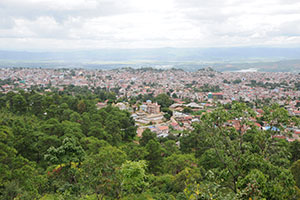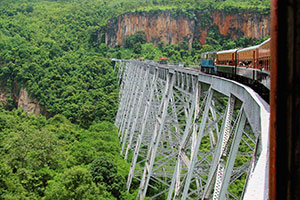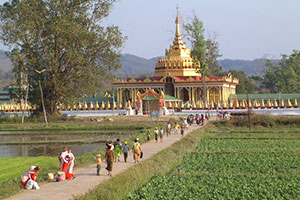
Shan State And Around
Shan State
 Nearly a quarter of Myanmar´s geographical area is occupied by the Shan State. This elevated land (up to 1000 m above sea level) forms a geological bridge to Thailands Northwest. Shan State is structured by mountains up to 2000 m high and divided into a North and a South portion by Thanlwin (Salween) River. Half of the people are ethnic Shan, living in the valleys of Salween River. Despite the altitude, Shan State is still well suited for cultivation of paddy rice, but the crop flourishing especially at high elevation is papaver somniferum, the poppy for opium production.
Nearly a quarter of Myanmar´s geographical area is occupied by the Shan State. This elevated land (up to 1000 m above sea level) forms a geological bridge to Thailands Northwest. Shan State is structured by mountains up to 2000 m high and divided into a North and a South portion by Thanlwin (Salween) River. Half of the people are ethnic Shan, living in the valleys of Salween River. Despite the altitude, Shan State is still well suited for cultivation of paddy rice, but the crop flourishing especially at high elevation is papaver somniferum, the poppy for opium production.Gokteik Viaduct
 60 km to the north, on the way from Pyin Oo Lwin to Lashio, in the midst of Shan mountains, is Gokteik railway viaduct (it is forbidden to take pictures!). It was about 100 years ago, when British colonialists asked an American steel company to construct this railway viaduct, overspaning a deep natural gorge. At those days Gokteik viaduct has been the second highest in the world. Even today, it’s nicer to see it from outside than to ride over it..
60 km to the north, on the way from Pyin Oo Lwin to Lashio, in the midst of Shan mountains, is Gokteik railway viaduct (it is forbidden to take pictures!). It was about 100 years ago, when British colonialists asked an American steel company to construct this railway viaduct, overspaning a deep natural gorge. At those days Gokteik viaduct has been the second highest in the world. Even today, it’s nicer to see it from outside than to ride over it..Thibaw / Hsipaw
 Close to road and railway connections between Myanmar and China, on the way from Mandalay and Lashio, an Austrian lady was part of a drama written in Burmese history of the 50ties: “Honourable Mahadevi from Hsipaw” became the wife of a Shan prince and played an important role in this area until 1962, when in Yangon military took power. The nephew of the prince now takes care of the palace and may tell to visitors interesting stories about bygone times. Nowadays the town of Thibaw and the area surrounding became a traveller´s hangout thanks to its cool and pleasant climate and relaxed athmosphere. The Bawgyo Pagoda is the most sacred one in northern Shan State.
Close to road and railway connections between Myanmar and China, on the way from Mandalay and Lashio, an Austrian lady was part of a drama written in Burmese history of the 50ties: “Honourable Mahadevi from Hsipaw” became the wife of a Shan prince and played an important role in this area until 1962, when in Yangon military took power. The nephew of the prince now takes care of the palace and may tell to visitors interesting stories about bygone times. Nowadays the town of Thibaw and the area surrounding became a traveller´s hangout thanks to its cool and pleasant climate and relaxed athmosphere. The Bawgyo Pagoda is the most sacred one in northern Shan State.Lashio
The township of Lashio, located at the southern end of famous Burma Road, is home for a majority of Chinese (“Shan-Chinese”). There are no important sights at all beyond the temple Quan Yin Sancars, built about 50 years ago for the most important Goddess of Chinese Buddhism in true Chinese style. Situated in a mountain basin, Lashio weather forecast means gamblin
Muse
Golden Triangle
Tachileik
Kyaing Tong
Tucked away in the far eastern corner of the Shan Sate, 456 km north-east of Taunggyi and 165 km north of the border town of Tachileik, Kyaing Tong is a sleepy but historic centre for Khun culture. Built around a small lake, doted with ageing Buddhist temples and crumbling British colonial architecture, Kyaing Tong is probably the most scenic town in the Shan State. From here the adventurous tourist may start trekking tours, ranking from soft to ambitous trekking, to tribal villages nestled in monsoon forests nearby (Iquor, An, Wa and Lahu). From Kyaing Tong excursions as far as to the Chinese border are easily arranged.
Contact Us
Information
WhatsApp : 09 250197881
info@myanmarphotographytour.com,
winthandarandassociatestravels@gmail.com
Travel Tips
- Embassies In Myanmar
- Arrival & Departure Procedure
- Myanmar Embassies Abroad
- Do & Don't
- Gazetted Holidays In Myanmar
- Life Style In Myanmar
- General information about Myanmar visa
- Travel Tips
- Our Services
- Naga History
We specialize in Myanmar also known as Burma because with our roots and our years (22 years travel industry )of experience.
